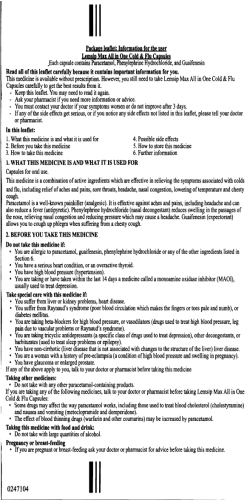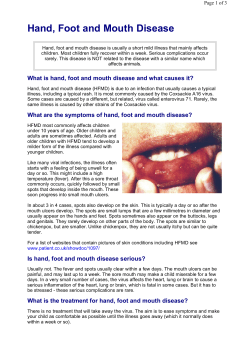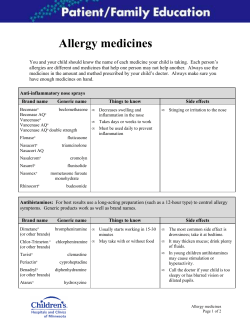
Paracetamol and Ibuprofen
Parent & Carer Information Brochure Paracetamol and Ibuprofen for Infants & Children This brochure contains information to help you use paracetamol safely. It answers some common questions parents and carers ask about paracetamol, so make sure you read through the whole brochure first. If you need more information, please ask your pharmacist, doctor or nurse. SUMMARY 1. Paracetamol (eg Panadol®, Dymadon®, Chemist’s own paracetamol®) may be used to relieve pain and troublesome symptoms associated with high fever. 2. Follow the instructions on the bottle or packet to work out the correct dose of paracetamol for your child. 3. Paracetamol can be harmful if given in large doses, more often than four times per day or for longer than recommended. 4. Ibuprofen (eg Nurofen®) is different from paracetamol. It may also be used to relieve pain and troublesome symptoms associated with high fever, but paracetamol is preferred in most instances. 5. Do not give ibuprofen and paracetamol together for the treatment of fever. 1. WHICH MEDICINES CONTAIN PARACETAMOL? ✵ Paracetamol is the name of the active ingredient in many medicines used to relieve pain or the symptoms of colds and flu. These are sold under many different brand names. ✵ In some medicines, paracetamol is the only active ® ® ® ingredient ( eg Panadol , Dymadon , Panamax , ® Chemists’ own paracetamol ). ✵ In other medicines, paracetamol is combined with ® ® other active ingredients ( eg Panadeine , Painstop , ® ® Codral , Dimetapp ). ✵ Paracetamol containing medicines are available in many different forms and strengths, including tablets, capsules, liquids and suppositories. Always read the label to see if your child’s medicine contains paracetamol, so that you do not give too much paracetamol by mistake. ✵ If your child needs medical attention, take your child’s medicines with you to show your doctor or nurse. The active ingredients are listed on the label of the medicine. 2. BEFORE YOU GIVE PARACETAMOL Check whether your child has a medical problem which may affect paracetamol use. ✵ Paracetamol might not be recommended or may need to be used in lower doses in children who have certain medical conditions (eg liver disease, prolonged fasting, dehydration) or who are taking certain medicines (eg anticonvulsants). ✵ Talk to your doctor or pharmacist if you are unsure about this. 3. WHEN SHOULD YOU GIVE PARACETAMOL? PAIN FEVER ✵ Children experiencing pain should be given Most children tolerate low-grade fever well o (38.5 C or less) and usually do not need paracetamol. adequate pain relief. ✵ For persistent pain, give regular doses of paracetamol ✵ Fever by itself is generally not harmful. It is a normal according to the directions on the label and your doctor’s instructions. and positive response in helping the body fight infection. If paracetamol does not relieve the pain, contact your doctor. ✵ Take your child with fever to your doctor first if: ✵ Children having operations often need medicines for pain when they go home. Your doctor or nurse will advise you about when you can safely start giving paracetamol or other pain relieving medicines at home. ✵ If your child has severe pain, you may be advised to ® give a paracetamol+codeine mixture (eg Painstop ). DO NOT give paracetamol and other paracetamol containing mixtures at the same time, as you could give more than the MAXIMUM SAFE dose of paracetamol. 1. he/she looks very sick 2. he/she is very young (eg less than 6 months of age) 3. you are giving regular paracetamol (every 4 to 6 hours) for high fever over a 24 to 48 hour period. ✵ Give paracetamol only if fever is high (greater than o 38.5 C, measured with a thermometer under the arm) AND your child is uncomfortable or miserable. Always use a thermometer to decide whether your child has a fever. ✵ Some children develop febrile convulsions (fits) with high fevers. Giving paracetamol has not been proven to prevent febrile convulsions. 19 out of 20 children with fevers will never have a febrile convulsion. 4. HOW MUCH PARACETAMOL TO GIVE? Follow the instructions on the bottle or packet to work out the dose. DO NOT guess the dose. ✵ If your child is particularly large or small for his/her age, first check the dose with your doctor. ✵ Paracetamol is usually given by mouth as a liquid or tablet. Liquid paracetamol products come in different strengths and forms. ✵ The amount (mg) of paracetamol in each mL of liquid is different for different products; for example, some infant drops are more concentrated than liquids for older children. 5. WHAT ELSE DO YOU NEED TO KNOW ABOUT PARACETAMOL? How often should you give paracetamol? ✵ Paracetamol is usually given every 4 to 6 hours, up to 4 times per day. ✵ Do not give paracetamol more than 4 times in 24 hours unless advised by your doctor. ✵ Do not wake a child to give paracetamol. ✵ Keep a written record of when and how much paracetamol you have given. How long should you give paracetamol? DO NOT give paracetamol regularly for more than 48 hours, unless advised by a doctor. If giving a liquid, check that the strength is correct for your child’s age. Side effects ✵ DO NOT confuse the strengths, as this could lead to ✵ Paracetamol has very few side effects when used in recommended doses. giving the wrong dose. ✵ Always use an accurate measuring device such as a metric medicine measuring cup, measuring spoon or dropper. These are usually provided with the medicine. ✵ DO NOT give young children adult-strength ® ✵ Paracetamol can be harmful to the liver if given in large doses, more often than four times per day or for longer than recommended. ✵ See your doctor if your child becomes unwell while taking paracetamol. preparations (eg Panadol Extend ). If giving tablets to older children, do not exceed the maximum adult dose. ✵ Your doctor may give you different dosing instructions for a particular illness. Use these instructions only for that illness and that child. Do not use these dosing instructions for other children or other illnesses in the same child. If you think you have given too much paracetamol (overdose), contact the Poisons Information Centre (Telephone 131126) or your doctor, or go to the nearest hospital emergency department. Do this even if your child does not seem sick. The harmful effects of large amounts of paracetamol on the liver are usually delayed, so children may feel well for the first day after an overdose but become very sick after that. 6. WHAT ABOUT IBUPROFEN? ® ® ® (eg Nurofen , Bugesic , Brufen ) ✵ Ibuprofen is a medicine that’s different to paracetamol. It comes from the same family of medicines as aspirin. ✵ Ibuprofen may cause side effects involving the digestive system or kidneys in some people. ✵ Ibuprofen can be used to treat pain and troublesome symptoms associated with fever. Pain ✵ Ibuprofen is useful as a treatment for some acute pain (eg after some operations) and chronic pain conditions (eg arthritis). ✵ It may be given together with paracetamol for severe pain. For example, after some operations, your doctor or nurse may advise that you give both medicines for a short period. This is different to the recommendations for use in fever (see below). ✵ If your child needs to have surgery, ask your doctor whether you should give ibuprofen. Ibuprofen may not be recommended before or after certain types of surgery. Fever ✵ Paracetamol is the first choice if treatment is required for troublesome symptoms associated with high fever. ✵ Ibuprofen may be recommended by some doctors to treat fever. 7. COMMON MISCONCEPTIONS What about settling a child? ✵ DO NOT give paracetamol or ibuprofen to "settle" a child at night, as these medicines do not cause sleepiness. What about immunisations? ✵ Paracetamol does not need to be given routinely before immunisations. This was recommended in the past, but is no longer advised as the current vaccines have fewer side effects. 8. STORING THE MEDICINE For all medicines, including paracetamol: ✵ Keep out of reach of children. ✵ Leave in the same bottle/packet as when purchased. ✵ Store in a child proof cabinet and away from light and heat. 9. WHERE TO SEEK MORE HELP Poisons Information Centre Ph: 131126 Kidsnet Ph: (02) 98452432 For general information about managing your child’s pain and fever please see: ✵ "Children’s pain – the facts" at www.sch.edu.au or www.chw.edu.au ✵ "Fact sheet – fever" at www.sch.edu.au or www.chw.edu.au ✵ DO NOT give ibuprofen with paracetamol to treat fever, as this has not been shown to be safe or effective. © Sydney Childrens Hospital, Randwick and University of NSW Improving Medication Safety in Children Project Date produced: June 2005 I Review date: April 2007 SCH05-142
© Copyright 2026



















